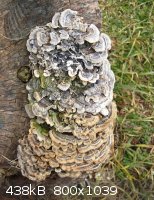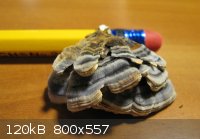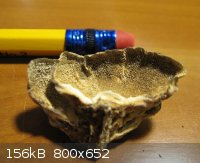White Yeti
National Hazard
   
Posts: 816
Registered: 20-7-2011
Location: Asperger's spectrum
Member Is Offline
Mood: delocalized
|
|
Extracting polysaccharide K from mushrooms.
I found out today that a tree stump in my yard was populated with Trametes versicolor a ubiquitous and useful mushroom. It contains polysaccharide K
that has interesting anticancer properties. I'll upload pictures later, but I was wondering how I could extract this polysaccharide from the mushroom.
I just can't find any documentation on the process.
Any ideas? Should I use a polar solvent or a nonpolar solvent?
[Edit]
Here are the pictures I promised. I was having a little trouble with iPhoto, sorry for the delay.



[Edited on 1-2-2012 by White Yeti]
"Ja, Kalzium, das ist alles!" -Otto Loewi
|
|
|
zoombafu
Hazard to Others
  
Posts: 255
Registered: 21-11-2011
Location: U.S.
Member Is Offline
Mood: sciencey
|
|
polysaccharides are usually insoluble in water, so a non-polar solvent would probably be what you need.
This is from wikipedia:
"Since PSK is an isolated component of Trametes versicolor, and not an isolated compound, the main structure can only be summarized by close
approximations. The approximate molecular weight of PSK is 94,000–100,000 Da and its main polysaccharide chain consists of a beta-glucan linked via
β-1,4 bonds. There are also β-1,3 side chains present, as well as β-1,6 side chains. The β-1,6 side chain regions are where the
protein structure is attached on PSK (either through a O- or N- glycosidic bond)."
Polysaccharide K
Here is a link to a scientific study on it:
http://cebp.aacrjournals.org/content/4/3/275.full.pdf
[Edited on 2-1-2012 by zoombafu]
|
|
|
resveratrol
Hazard to Self
 
Posts: 65
Registered: 6-11-2010
Member Is Offline
Mood: No Mood
|
|
I don't know much about the species, but you might want to check out that green before extracting. I'm sure it's a lichen and that's probably just
algae.
|
|
|
smaerd
International Hazard
    
Posts: 1262
Registered: 23-1-2010
Member Is Offline
Mood: hmm...
|
|
This is something I am interested in as well. I found a little journal article about it, hopefully it helps to point in the right direction. If anyone
finds anything more definitive, please post  . .
Attachment: polysacharides from medicinal mushrooms.pdf (399kB)
This file has been downloaded 588 times
|
|
|
zoombafu
Hazard to Others
  
Posts: 255
Registered: 21-11-2011
Location: U.S.
Member Is Offline
Mood: sciencey
|
|
great pdf smaerd!
Also in my search for information i got the impression that no one actually 'isolated' the compound, i think they just test patients concentrated
mushroom mass of some sort.
|
|
|
White Yeti
National Hazard
   
Posts: 816
Registered: 20-7-2011
Location: Asperger's spectrum
Member Is Offline
Mood: delocalized
|
|
Great PDF smaerd! Page 11 was exactly what I was looking for. I don't have ethanol, wonder of isopropyl can be substituted for ethanol... In the end,
the ethanol is used to remove alcohol soluble components, isopropyl should get the job done just as well as ethanol.
"Ja, Kalzium, das ist alles!" -Otto Loewi
|
|
|
overload
Hazard to Self
 
Posts: 66
Registered: 9-7-2011
Location: USA
Member Is Offline
Mood: miserable fat slave
|
|
Quote: Originally posted by White Yeti  | | Great PDF smaerd! Page 11 was exactly what I was looking for. I don't have ethanol, wonder of isopropyl can be substituted for ethanol... In the end,
the ethanol is used to remove alcohol soluble components, isopropyl should get the job done just as well as ethanol. |
Isopropyl is toxic when ingested and may act differently than expected so distil some vodca. What's the texture like? Rock hard or rubber? Does it
smell?
|
|
|
White Yeti
National Hazard
   
Posts: 816
Registered: 20-7-2011
Location: Asperger's spectrum
Member Is Offline
Mood: delocalized
|
|
Quote: Originally posted by overload  |
Isopropyl is toxic when ingested and may act differently than expected so distil some vodca. What's the texture like? Rock hard or rubber? Does it
smell? |
Ethanol is also toxic when ingested. The LD50 for isopropyl is 5050 mg/kg according to wikipedia. The LD50 for ethanol is 5628 mg/kg. Granted, ethanol
is less toxic than isopropyl, but not by much.
We're also talking extractions here, the ethanol (or other alcohol) is discarded after extracting the alcohol soluble components of the mushrooms. The
mushrooms are then boiled in water for several hours to get rid of water soluble components (the remaining isopropyl boils off as well). After that,
you'd be lucky if you had as much as a hint of the smell of isopropyl.
For the texture of the mushrooms, I'd say that the ones that I took off the stump are brittle because they are dehydrated. The rest of them are pretty
hard, but that may be due to the sub freezing temperatures of the outdoors.
"Ja, Kalzium, das ist alles!" -Otto Loewi
|
|
|
Ozone
International Hazard
    
Posts: 1269
Registered: 28-7-2005
Location: Good Olde USA
Member Is Offline
Mood: Integrated
|
|
This is not trivial. Given unlimited time and student-power, I'd:
0. Harvest (via culture) a large (HUGE) amount of bona-fide fungi.
1. Dry and powder it.
2. Extract with hexanes (or, better, 10% EtOH in benzene) to defat/dewax.
3. Boil with buffered water, filter. Keep both the cake and filtrate. Repeat at least twice more. Discard (or hold) the cake.
4. Evaporate the water extract to about 200 mL. Optionally, deproteinate the aqueous phase with 40% TCA or some other means (Ba(OH)2 comes to mind),
and filter or centrifuge (best). Keep the centrifugate for the next step.
5. Crash the whole mess into enough EtOH to make the mix ~80 % EtOH. This works best by pouring the aqueous extract into the alcohol slowly, with
vigorous stirring (mag-bar works well).
6. Let the ppt. settle and decant the clear alcohol (keep it if you want); filter the rest through paper. While wet, wash with acetone and fluff with
a spatula to get a polysaccharide powder (or lyophilize).
7. Reboil (perhaps with some MgCl2) to solublize and either fractionally ppt in EtOH or dialyze in the appropriate membrane to get the MWCO you want
(>90 kDa <125). Check MW either (rather arbitrarily) with GPC/DRI or (absolutely) with GPC/DLS.
8. Lyophilize the fraction(s) you want. Check those for activity.
9. Further fractionate until you think you have a single active form.
10. Crystallize and perform XRD for structure, perform automated Edman degradation for the sequence.
11. Publish your ass-off and write your Dissertation (or three).
It will take years, but your diligence will pay-off,
O3
-Anyone who never made a mistake never tried anything new.
--Albert Einstein
|
|
|
overload
Hazard to Self
 
Posts: 66
Registered: 9-7-2011
Location: USA
Member Is Offline
Mood: miserable fat slave
|
|
Quote: Originally posted by White Yeti  | Quote: Originally posted by overload  |
Isopropyl is toxic when ingested and may act differently than expected so distil some vodca. What's the texture like? Rock hard or rubber? Does it
smell? |
Ethanol is also toxic when ingested. The LD50 for isopropyl is 5050 mg/kg according to wikipedia. The LD50 for ethanol is 5628 mg/kg. Granted, ethanol
is less toxic than isopropyl, but not by much.
We're also talking extractions here, the ethanol (or other alcohol) is discarded after extracting the alcohol soluble components of the mushrooms. The
mushrooms are then boiled in water for several hours to get rid of water soluble components (the remaining isopropyl boils off as well). After that,
you'd be lucky if you had as much as a hint of the smell of isopropyl.
For the texture of the mushrooms, I'd say that the ones that I took off the stump are brittle because they are dehydrated. The rest of them are pretty
hard, but that may be due to the sub freezing temperatures of the outdoors. |
Do what you think will work best.
|
|
|